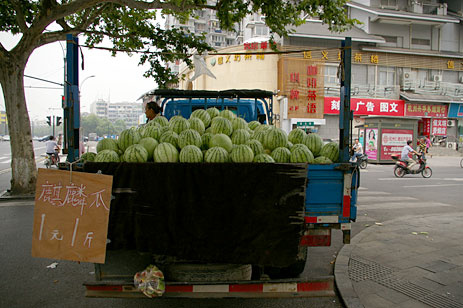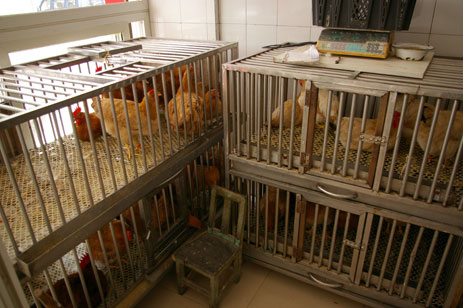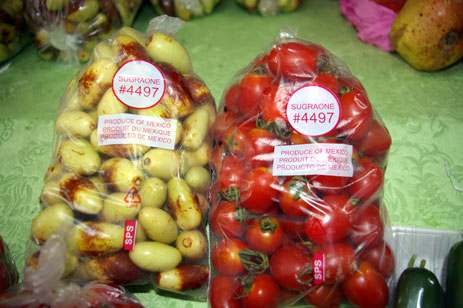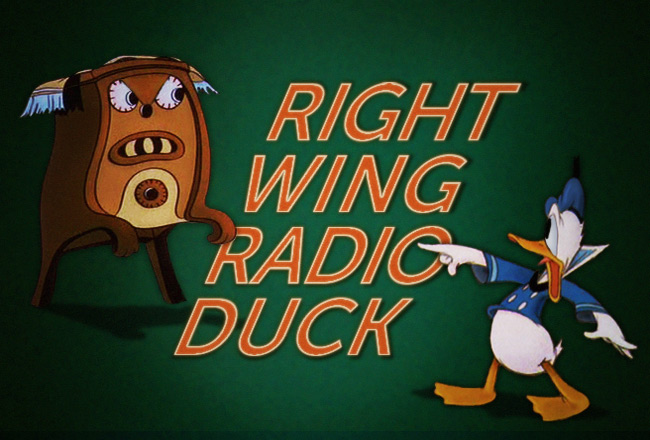 Is that a giant cucumber or are you just happy to see me? My local produce market features donggua, or winter melons.Photos: Andrew Stein
Is that a giant cucumber or are you just happy to see me? My local produce market features donggua, or winter melons.Photos: Andrew Stein
 I’m in Hangzhou, the capital of China’s fertile Zhejiang province.I’ve lived happily for months under the impression that I eat locally. Within one block of my apartment, in downtown Hangzhou, the capital of China’s rich and fertile Zhejiang Province, I can take care of almost all my food needs by supporting the little, local guy. No need for supermarkets when you’ve got great local food available!
I’m in Hangzhou, the capital of China’s fertile Zhejiang province.I’ve lived happily for months under the impression that I eat locally. Within one block of my apartment, in downtown Hangzhou, the capital of China’s rich and fertile Zhejiang Province, I can take care of almost all my food needs by supporting the little, local guy. No need for supermarkets when you’ve got great local food available!
Then, one day, cutting veggies for an omelet in my kitchen, I was awoken by a mid-summer’s ripe tomato. Emblazoned across its shiny red face was a sticker that read “Yunnan.”
Hey! That’s not local, I thought. Heck! Yunnan is as far from Hangzhou as Dallas is from New York City.
I wondered: Just how local are these foods I’ve been eating?
With reusable water bottle in hand and organic cotton socks pulled up tight, I set off to see where my food really comes from.
 Seedy business: China is the biggest producer of watermelons in the world.Veggie whiz
Seedy business: China is the biggest producer of watermelons in the world.Veggie whiz
Along the way, I encountered a truck piled high with watermelons. Herds of these trucks ascend from the southern Zhejiang town of Wenling, located 400 kilometers away. Why stampede so far to sell watermelons? The answer is obvious — the Wenling watermelon market is saturated, and Hangzhou fetches the highest prices around.
Selling watermelons in Hangzhou, however, could cost the Wenling watermelon farmers more than just gas fees and fresh air. If caught by a regulatory official called a chengguan, the vendor’s truck and melons will be confiscated because they aren’t legally registered to sell within the city limits. When I asked them about the police, a separate entity in China, the vendors replied, “The police don’t care. Only the evil chengguan cares. So, we sell watermelons before the chengguan begins work at 6 a.m., when he has a lunch break, and after he quits for the day at 6 p.m.”
Happy that the chengguan doesn’t control my livelihood, I marched off to the local vegetable stand run by ruddy-faced Mr. Wang.
Hangzhou is surrounded by fertile farmland and has a long growing season. Most of Mr. Wang’s veggies must come from the Hangzhou area … where else could they be from? Maybe Mr. Wang even grows some of his own vegetables.
Mr. Wang’s rosy glow, unfortunately, doesn’t come from cultivating heirloom tomatoes. He doesn’t have time to grow anything, since he begins every day at 2 a.m. — gathering produce, delivering it to restaurants, and returning in time for his early morning customers.
Mr. Wang’s wares come from two major wholesale markets: Gouzhuang and Xiasha. Gouzhuang is the largest wholesale food market in Hangzhou, located eight kilometers away. The smaller Xiasha Market is located a further 20 kilometers away. The chief difference, distance aside, between Gouzhuang and Xiasha is that Gouzhuang’s foodstuffs come primarily from other provinces, while Xiasha’s come from the greater Hangzhou area.
Based on the murky information that Mr. Wang provided, it’s possible that two-thirds of his veggies come from the Hangzhou area.
Why don’t all of them come from local vendors? “Two reasons,” says Mr. Wang. “The supply of Hangzhou veggies doesn’t meet the demand, and the Gouzhuang market is close and convenient, offering the city’s largest selection of produce.”
I’m inclined to believe that the second reason hits closer to the truth. Every morning he drives to Gouzhuang because it’s closer, faster, and more convenient than going to Xiasha, and those priorities tend to rule even in modern Chinese culture.
 Happy or not too happy? Chickens at the market.Bird hunting
Happy or not too happy? Chickens at the market.Bird hunting
Next to Mr. Wang’s is the tuji, or “free range chicken” stand where I get my fresh chickens. In this setting, I can see that the chickens are alive and in decent health — they hop around, they’re alert, and, ultimately, they aren’t the nightmarish products of American industrial agriculture portrayed in Food Inc. When you buy a chicken, it’s weighed, slaughtered, and butchered right in front of you. It feels good to get a closer glimpse of my food source and see it treated with a higher level of respect than death by lifeless-metal-killing-machine.
But how much of the source do I really see? It’s certainly ironic that all of these “free-range chickens” are in cages.
And now I wonder, am I really supporting local foods?
In part, yes: I’m supporting a local vendor who makes a commission on chicken sales. It’s also likely that the chicken was raised within Zhejiang Province, since this chicken stand is part of the large provincial livestock corporation Zhenning, based out of Ninghai County 250 kilometers away. But as I watched a truck full of crated chickens pull up, I began to think that this wholesome, liberated chicken might not be as wholesome as I thought.
“Where exactly are these chickens raised?” I asked.
“The mountains,” replied the owner, pointing to a poster with ten ambiguous mountain names.
“Where are these mountains located?”
“I don’t know. That’s the corporation’s deal, not mine.”
My careful questions about the use of steroids, antibiotics, and chicken feed were all met by Mr. Chicken with a variation on “That’s the corporation’s deal.”
In search of answers I went to Zhenning’s website, which says that their chickens get a balanced diet from local products and boasts that its mill produces over three tons of feed annually. However, it doesn’t tell its customers exactly where the chickens are raised and what exactly they’re fed.
Feeling a bit queasy about my poultry source, I crossed the street to The Good Neighbor Fruit Stand.
The first words out of the owner’s mouth were, “I don’t know where this fruit comes from! I just get it from Gouzhuang market. I only know the price.”
 Expatriotic: Chinese merchants often fake foreign labels as they are associated with higher quality than domestic produce.< /span>Since many fruits were labeled, I decided to have a look. Although Zhejiang produces a wide range of fruits, this store only had one product for sale that was grown within the province. Even more disturbing than the distance the fruit traveled was its mislabeling.
Expatriotic: Chinese merchants often fake foreign labels as they are associated with higher quality than domestic produce.< /span>Since many fruits were labeled, I decided to have a look. Although Zhejiang produces a wide range of fruits, this store only had one product for sale that was grown within the province. Even more disturbing than the distance the fruit traveled was its mislabeling.
“You have a lot of fruit from Mexico,” I commented.
“No,” said the owner. “That’s just the label on the bags. All of that fruit is from somewhere in China.”
When I reached the Taiwan mangos, a worker whispered, “Though the label says Taiwan, those are actually from Hainan Province.” I realized that this is probably because many Chinese believe imported foods to be safer and more precious than mainland domestic products — and thus worthy of a price markup.
Before leaving, the owner’s wife stopped me. “Let me tell you something,” she said. “We don’t know anything about this fruit. If you want to know more about it, go to Gouzhuang.”
Back on the street, I bumped into a police officer. I looked up and found myself between another Zhenning “free-range chicken” stand and a Wenling watermelon truck.
Curious, I asked the officer, “Do you mind the Wenling farmers selling watermelons?”
“Not at all,” he replied.
“Is it not illegal?”
“Well, I’m not going to stop them. That’s the chengguan’s responsibility. These people are from the poor countryside. How else will they make ends meet?”
Although it was apparently illegal, the watermelon that I bought from the Wenling farmers had the most direct link to its source, had the only vendor that could tell me how the product was cultivated, and was likely the most local food I bought all day.
Reusable water bottle still in hand, I strolled home with one thing in mind — hunting the beast that is Gouzhuang.



